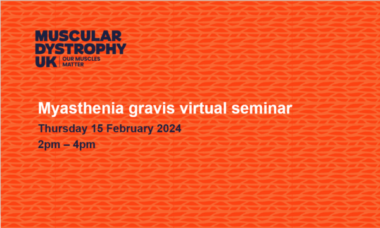Myasthenia gravis (MG) is a chronic autoimmune condition that causes fatigable muscle weakness, with the muscles around the eyes usually affected first. MG is more common in women than men. Symptoms usually start in women under 40 and men over 60, but the condition can affect people of all ages. MG can vary in severity and areas of weakness but is usually manageable with medication and supportive therapies.
Myasthenia gravis (MG)
MG causes weakness that gets worse with repeated muscle use and improves with rest. This is called fatigable muscle weakness. Symptoms fluctuate and are typically worse towards the end of the day. Hot weather, infections, stress, or menstrual periods can trigger symptoms.
Myasthenia gravis can be classified as either ocular myasthenia or generalised myasthenia gravis.
- Ocular myasthenia only affects the eye muscles.
- Generalised myasthenia gravis begins in the eyes and spreads to other muscle groups in the body. This type is more common.
Eyes
In most cases, MG affects the muscles controlling eyelid and eye movements first. This can cause droopy eyelids (ptosis), where one or both eyelids weaken and may cover the eyes and affect vision. It can also lead to blurred or double vision (diplopia). The severity can change day to day and is often worse at the end of the day.
Face, mouth, and throat
Facial muscle weakness in generalised MG can make it difficult to make typical facial expressions, such as smiling or frowning, and can affect speech.
Weakness in the mouth and throat muscles can cause difficulty chewing and swallowing (dysphagia). This may result in coughing and choking during meals, feeling like food is stuck in the throat or chest, or the inhalation of food or drink into the lungs (aspiration). Inhalation can lead to chest infections (aspiration pneumonia).
Those affected may have slurred speech and a quiet or nasal-sounding voice. Their breathing muscles may be mildly affected and cause shortness of breath when lying down or after exercise.
Other parts of the body
Weakness can affect other parts of the body such as the neck, arms, and legs in generalised MG. The severity is different for everyone and fluctuates.
- Neck weakness can make it difficult to hold the head up.
- Arm weakness can make it difficult to raise the arms above the shoulders, making functional tasks such as reaching for objects or getting dressed harder.
- Leg weakness can make it difficult to walk longer distances and climb stairs. As a result, there may be an increase in the risk of falls.
Fatigue
People with MG often experience fatigue, which feels like exhaustion and affects energy levels and the ability to perform daily activities. Fatigue can still be experienced even if the condition is well managed. Read about fatigue and managing fatigue.
MG is an autoimmune condition. This means the body’s immune system, which normally protects the body, mistakenly makes antibodies that attack its own healthy tissues or proteins, instead of fighting infections. Some people are more likely to develop autoimmune conditions because of their genetic makeup, containing small changes in many genes, which they have inherited.
In most cases, people with MG produce antibodies against a protein called the acetylcholine receptor (AChR). The acetylocholine receptor is found at the point where the nerves and muscles meet (the neuromuscular junction); it helps muscles move by receiving signals from nerves. The antibodies people with MG produce block these receptors and make it harder for muscles to get the signal. This causes muscle weakness, which worsens with repeated muscle use.
Some people produce antibodies against a different protein, muscle-specific kinase (MuSK), which also disrupts communication between nerves and muscles, leading to similar muscle weakness. Other rare antibodies such as LRP4 have been found in some people with MG, and there are some people without known antibodies (called seronegative myasthenia gravis).
It’s not clear why this happens. In some cases, the thymus gland in the chest might trigger the abnormal immune response, especially in younger people. Trials have shown that removing the thymus can improve symptoms in younger people with recent MG onset. At least 1 in 10 people with MG have a thymoma, which is usually a benign (non-cancerous) tumour of the thymus gland, although estimates in some populations are much higher.
A GP can make a referral to a neurologist for testing. A neurologist is a doctor who specialises in conditions affecting the muscles and nervous system. They will carry out a physical examination and discuss medical history. A blood test can look for a high level of specific antibodies associated with MG. Some people with MG, especially ocular myasthenia, may not have high levels of antibodies. In these cases, the blood test may be repeated if symptoms continue or worsen. Additional tests, such as electrical testing to check the nerves and muscles, and a chest scan (CT or MRI) may also be used. The chest scan will check the thymus gland for abnormalities. Treatment options will be discussed after diagnosis.
For more information, see our diagnosis page.
A multi-disciplinary approach is important in not only managing the condition and symptoms, but in improving wellbeing too.
Access to a healthcare team
People with MG should have access to a multi-disciplinary healthcare team, with different healthcare professionals working together, to assess their condition and discuss treatment. Usually, the lead professional will be a neurologist in a specialist neuromuscular clinic. If you do not have contact with a neurologist or specialist doctor, speak to your GP about getting access.
Avoiding triggers
Symptoms of MG sometimes have a trigger. Noticing and avoiding triggers, as much as possible, may help.
Common triggers include:
-
- Stress
- Tiredness and fatigue
- Infections – people should receive a pneumococcal vaccine and annual flu jab (advice is needed before having a “live” vaccine).
- Certain medications and anaesthetics
Medications
- Pyridostigmine – the first treatment for MG is pyridostigmine, which helps electrical signals travel between the nerves and muscles. It reduces muscle weakness, but the effect only lasts about four hours, so it needs to be taken regularly. People with mild symptoms may only need pyridostigmine to manage their condition, but most will need more treatments. Possible side effects include stomach cramps, diarrhoea, and feeling sick. A lower dose or other medication can be prescribed to help with side effects.
- Steroids – if pyridostigmine is not enough to control symptoms, steroid tablets can be prescribed to reduce immune system activity. Prednisolone is started at a low dose and is gradually increased over a few weeks. Once symptoms improve and are stable, the dose is slowly reduced to the lowest effective amount. Some people can stop taking steroids if they go into remission (become symptom-free).
Steroids can have side effects, such as increased risk of infections, high blood pressure, and weakening of the bones (osteoporosis). Regular monitoring and additional medications can help manage these risks. Steroids can increase blood sugar levels, which may lead to diabetes in people who are already at risk, even if they didn’t previously show symptoms. Maintaining a healthy diet is important to help manage the risk of weight gain. Don’t stop taking steroids suddenly, as this is dangerous and has serious health risks. It’s important to carry a Steroid Emergency Card, as it provides important information for healthcare professionals in an emergency. The card can be obtained from a GP, community pharmacy, or specialist hospital team. - Other immunosuppressants – if steroids are not controlling symptoms or a very high dose is being used, doctors may prescribe immunosuppressants, such as azathioprine, methotrexate, mycophenolate, or rituximab. These medications can help lower or even eliminate the need for steroids by reducing immune system activity, though they take a few months to work. These medications have side effects, so regular blood tests are necessary.
- New treatments – recent clinical trials have shown that treatments such as efgartigimod, rozanolixizumab, and zilucoplan are effective for myasthenia gravis. These treatments are currently being evaluated for use in the UK by the National Institute for Health and Care Excellence (NICE). We, at Muscular Dystrophy UK, play a key role in these appraisals, often acting as a formal Patient Expert. For more information, see our access to treatments page.
Surgery
The thymus gland, located in the upper chest behind the breastbone, can be enlarged in people with MG. Surgery to remove the thymus gland, called a thymectomy, is recommended for those with a thymoma and for some patients with AChR antibodies without thymoma. This is usually recommended for younger patients with more recent condition onset. This surgery can help improve symptoms, depending on the specific antibody in the person’s blood. Symptoms usually improve in the first few months after surgery but could continue to improve for years. Surgery may reduce the amount of medication needed and reduce the chance of worsening symptoms that require treatment in hospital. Surgery should be discussed with a specialist. In many cases, this surgery can be done via keyhole surgery, which is less invasive and enables a quicker post-surgical recovery.
People with MuSK antibodies do not benefit from a thymectomy, as it can worsen their symptoms. It’s also not currently recommended for those who do not have detectable antibodies.
Thymoma is a rare tumour of the thymus gland. Not all people with thymomas have symptoms of MG. When thymomas are associated with MG, it’s recommended they are surgically removed. In some cases, additional treatment in the form of radiotherapy or chemotherapy may be necessary.
Emergency treatment
A myasthenic crisis is a severe worsening of MG symptoms, leading to extreme weakness and severe breathing or swallowing problems. These symptoms are potentially life-threatening and require emergency hospital treatment. Treatment usually includes either plasma exchange (which removes harmful antibodies) or intravenous immunoglobulin therapy (IVIg, which provides healthy antibodies) and steroids. In severe cases, people may be admitted to the intensive care unit (ICU) to use a ventilator machine to assist breathing.
Refractory myasthenia gravis
Refractory myasthenia gravis affects about 1 in 5 people and refers to cases where the treatments above fail to control symptoms sufficiently. In these cases, people will experience persistent or worsening symptoms despite medication, and treatment options are limited.
New treatments are being developed for MG. Information can be found on the access to treatments page.
Pregnancy
Planning to have a baby is important for anyone, but for a person diagnosed with MG, it’s important they discuss this with their neuromuscular team. Ideally, pregnancy should be planned to allow optimisation of MG treatment and stop any unsafe medications.
There should be close liaison between neuromuscular and obstetric teams to ensure a safe pregnancy. Pregnancy and delivery can sometimes worsen symptoms of MG, and the baby could be affected. During pregnancy, additional scans and appointments are needed to check for signs of transient neonatal MG. This condition occurs when antibodies pass across the placenta, temporarily affecting the baby at birth. Symptoms in the baby include a weak cry, feeding difficulties, and breathing problems. Treatment for the baby is like that of their parent and includes pyridostigmine.
Some medications can interfere with nerve to muscle transmission and worsen MG. These include some antibiotics, beta-blockers, and psychiatric drugs. A doctor must be made aware of a MG diagnosis when they prescribe new medication. A full list of medications can be found on Myaware.
Anaesthesia stops a person feeling pain during a procedure or surgery. If having surgery, the anaesthetist and surgical team must be aware of a MG diagnosis and treatments. They should carry out a pre-operative assessment, extended post-operative monitoring and liaise with the treating MG neurologist.

Author: Muscular Dystrophy UK
Reviewers: Dr Pablo Garcia-Reitboeck and Dr Georgina Burke
Last reviewed: March 2025
Next review due: March 2028
Myasthenia gravis webinar (2024)
On Thursday 15 February 2024 we held a webinar on myasthenia gravis. Watch to learn about the latest research, as well as tips and advice on living well with myasthenia gravis.

We are here for you
Webinars, Information Days, and support groups for our muscle wasting community. Our life-changing support is here for you.
Advice for living with or caring for someone with a muscle wasting condition.


